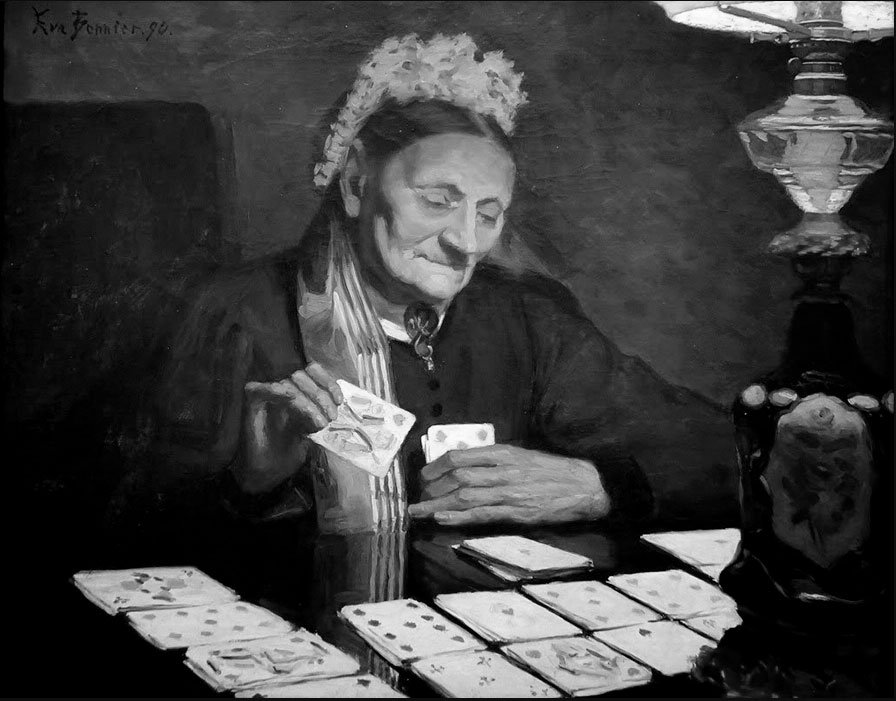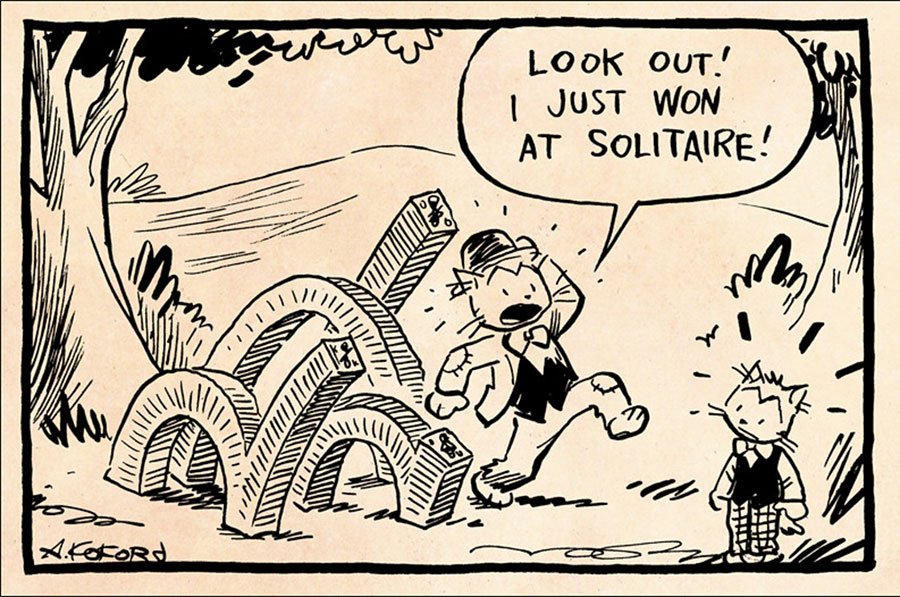Everyone in the world knows someone who regularly plays the Solitaire card game. Still many people don’t know that Solitaire is likely to be the most played card game in the world over the last 200 years. Most people think Solitaire is just one game. But there are thousands of different kinds of Solitaire games out there. Each one has a unique layout and rules, as well.

Principles of Solitaire
Solitaire is a card game played with one (or more) decks of 52 cards which is possible to play for one person. It is a card game that can be categorized as a game of skill with incomplete information and with an element of chance.
- The skill factor lies in the fact that the player influences the game’s outcome through his actions.
- The incomplete information is that the cards are primarily dealt face down.
- The luck factor relates to the fact that the cards are dealt with randomly.
The object of the game
At the start, the cards are dealt with according to a specific layout.
The goal for the player is to play the cards according to specific rules to a pre-designated final destination.
The Play
In a Solitaire game, cards may only be built (moved) based on an identical suit, alternating colors, or ascending or descending order. The starting position and exact rules for moving the cards differ between each type of Solitaire game.
Card game for one person
Originally Solitaire wasn’t expressly a card game for one person. There are many early historical references that more players play the game. But what sets Solitaire apart from any other card game is that every player has their own setup, so every game is possible to play alone.
Solitaire or Patience?
During the 19th century, there was a discussion about the name Patience for this type of card game. Although the game could also be played with multiple players, it was mainly a game you practiced on your own.
In many old books, you can read that there was already a lot of lobbying going on to change the name into Solitaire or Solitary.
There are still countries where the name Patience, a derivative, is used instead of Solitaire. But thanks to the internet, and most online games are in English, Solitaire can be seen as the official name that used to be Patience.
“The name of Patience was no doubt derived from the almost hopeless attempts to win games of this nature.”
Mr Pole, 1874

A Brief History of Solitaire with Cards
Who invented Solitaire and where the game originally came from is unknown. We know that the first description of a “Patience” game comes from Europe (France 1725) and that the first name used to describe this type of game was “patience.” Games of Patience became extremely popular all over Europe and in the United States.
“First described in a 1783 German manual as Das Patiencespiel, the game appeared just 20 years after the card layouts began to be used for cartomancy and fortune-telling. Which lends credit to the theory that Patience was initially a lighthearted attempt to forecast the future. Supposedly a favorite with young ladies, the game predicted nuptial destiny.
“If a player completed a sequence on the Ace of Hearts, she would find love, on Diamonds, she would be courted, Clubs foretold marriage, and spades a future of “single blessedness.”
“The new Games Treasury” by Merilyn Simonds
Some Historical Definitions of Patience and Solitaire
Through the years, many books have been written about this game. The first English books on Solitaire were written by Ednah Dow Cheney in the USA (1870 Patience Games for the FireSide) and by the noblewoman Lady Cadogan in the UK (1874 Illustrated Games of Patience). In this era, many new books on Solitaire were published by different writers. Here are some of their definitions of Patience and Solitaire:
Patience, as we know it, is not only an amusing but also an intellectual pastime. It naturally will not commend itself to the man who regards cards simply as a means of gambling, for whom the most scientific of card games has no interest beyond what it is possible to win or lose at it.
In almost all games of patience or solitaire, the principle involved is that of playing sequences’ ^ up ‘V or ** down,” changing colors each time so that a red four will require a black three upon it if one is playing ‘* down “; or a black eight will require a red nine if one is playing” up.’* When the object is to get the cards out of the pack in sequence and suit, separate piles are usually started with a particular card, called the “foundation,”; and each foundation pile must begin with a card of the same denomination.
“Patience Games, as the term is usually understood, are card games of a single player who plays against fate or chance, represented by the more or less favorable arrangement of the cards at the outset of the game.”
“A card game for one person is so to speak a match played with faith, the adversary being, in reality, the element of chance that enters into the game by shuffling the cards. These types of games are called Games of Patience.”
The Timeless Popularity of Solitaire
Even before Microsoft boosted the popularity of Solitaire (Klondike), it was already the most well-known type of Solitaire. Although it’s by far not the oldest.
For many people, one Solitaire game stands out, which is Klondike. It’s by far the most played and well-known Solitaire in the world. It’s so well known that most people use the word Solitaire to refer to Klondike specifically.
Microsoft Windows Solitaire (Klondike)
The current popularity of the Klondike game is clearly due to Microsoft installing the Klondike Solitaire on billions of computers worldwide.
In the 1990s, “Microsoft Solitaire” was included as part of the Microsoft Windows operating system. At that time, there weren’t many computer games yet, a few as easily accessed as Windows Solitaire. The game was installed by default, ensuring that anyone in the world with a computer had direct access to the game.
The Windows version of Klondike is one of the most played computer games in the world. In 2019 the game was inducted into the Video Game Hall of Fame, where the game received more votes than all other nominated games together.

What are the Different Types of Solitaire, and which one is the Most Popular?
With literally thousands of types of Solitaire games, all with their own unique Solitaire Set Up. It is impossible to name them all here. There are many beautiful old French names like La Bella Lucie, La Parisienne, La Chatelaine, La Croix d’Honneur and Rouge et Noir.
Several stand out as the most popular among the thousands of versions available. A good example is Spider, already a popular variation of Solitaire, which was included in the Microsoft Solitaire Collection.
Here is the list of the most popular Solitaire games in the world in 2022:
- Klondike (including Vegas Score)
- Spider (1,2 and 4 Suits)
- Freecell
- Pyramid
- Yukon
- TriPeaks
- Crazy Eights
- Scorpion
- Yukon
- Crescent
- Spite and Malice
- Ace of Spades
- Forty Thieves
Which Solitaires were among the Most Played Variants in the Past?
When people think of Solitaire, they most likely think of the triangle-shaped layout variant type of Solitaire. The word Solitaire is almost a synonym for the one-player card game we call Klondike today and the gambling variant we call Casino Solitaire– or Vegas Solitaire.
But back in history, things were different. The card game of Klondike is often called “Classic Solitaire,” but history teaches us that Klondike is not as classic as other variants.
The first Patience game ever described in books were Quadrille (1725) and “Das Patiencespiel” (1787), which later is identified in English literature as “Grandfathers Patience.”
“Old Patience”
One of the oldest variants is the game we today call Sir Tommy but was initially named “Old Patience.”
In many old writings, we discovered that “Old Patience” was the most played type of patience game for many decades. It’s also said to be the ancestor of many games of Patience. As with Klondike today, many people didn’t even know the existence of other types of Patience.
By the turn of the century, around 1890-1900, the dominance in popularity of “Old Patience” was slowly being taken over by other solitaires. Most likely, the fact that it’s almost impossible to finish the game played an important role herein.
Klondike
Around the 1900s Gambling House Solitaire was popular in gambling houses in New York and Chicago. But around the same time, the popularity of other Solitaire was gaining popularity as well. Seven Card Klondike, most likely invented by the sourdoughs in the Saloons, was rumored to be offered by Richard Canfield in his famous gambling House.
Although Klondike Solitaire never really took off as a gambling game in gambling houses, its notorious past helped the game to become widely popular among lonely souls who tried to beat the house for imaginary money. Another boost of popularity was gained by the launch of Microsoft Windows Solitaire.
Solitaire and Gambling
Most people do not associate gambling with Solitaire, which is not surprising since most Solitaires are not meant to be gambling games. However, many people don’t know that the most popular Solitaire still played today is derived from a Solitaire that was misused for gambling; and gained popularity in America in the early 1900s.
Despite the game not being profitable enough and eventually disappearing from gambling houses, its popularity did not fade. For many decades to follow, it was played by millions of Americans at home at the kitchen table for imaginary money.